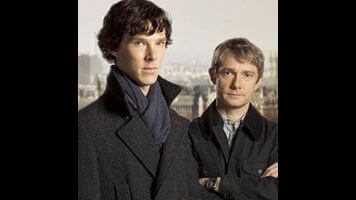Sherlock turns introspective with its silly sociopath of a superhero

A conflict of style and substance has always been at the heart of PBS’ Sherlock. Having sprung fully formed as a postmodern take on Sherlock Holmes’ deductive abilities, the show has struggled through sheer lack of substance to develop itself into more than a vessel in which Steven Moffat and Mark Gatiss can spin their yarns and Benedict Cumberbatch and Martin Freeman can launch their ships; those yarns have been at times thrilling, and Cumberbatch and Freeman remain impeccably cast, but the show has suffered from a lack of purpose when there was neither a story to start nor a story to bring to its exciting conclusion.
Sherlock’s third season never quite reconciles its trademark stylistic excess and its storytelling goals, but it embraces that tension as it shifts toward a more character-centric storytelling model. In the season’s second episode, where the series has historically struggled to tell meaningful stories, the writers shift their attention almost exclusively to its characters. It’s a trend that extends throughout the season, as Sherlock’s return from the dead becomes a linchpin for a three-episode study in who Sherlock Holmes is, who Sherlock Holmes cares about, and how the people around Sherlock Holmes have changed based on his presence.
It’s a noble goal, albeit one that would likely be better served with more than three episodes to achieve it. Moffat and Gatiss are enamored with Sherlock’s neuroses, so much so that they steer into the character’s conflicting personality traits: In the first episode in particular, Sherlock is silly and selfish, sociopathic and superheroic, in equal measure. There is much pleasure to be had with Sherlock, but the attempts to balance the dramatic implications of Sherlock’s return, the intense stakes of a national terrorist attack, and the character’s sense of fun becomes a tonal mishmash (especially when the show mistakes fan service for character development). The same stylistic elements that can work in the show’s favor become liabilities, dislocating the re-entry into the story and delaying the start of telling the next chapter once the nearly literal cliffhanger of season two is resolved.
Once that’s done, however, the show settles into telling character stories, with the second episode, “The Sign Of Three,” switching to finding mysteries within a personal event for the characters rather than creating character moments within a mystery. It’s an inversion that takes some time to settle, and creates further tonal issues, but it nicely sets the stage for a third episode that more successfully merges a large-scale mystery and a character study. That episode, “His Last Vow,” is the show at its best, and retroactively makes some of the earlier tonal challenges feel like a grand plan rather than a weirdly structured mess—a large-scale equivalent to Holmes pulling back the veil on a clever ruse.
The problem with this plan is that it inevitably feels rushed: While each episode may have a larger storytelling canvas than in your typical series, only having three episodes means large gaps of time between those stories, with no time to explore the characters living in everyday situations. The season wants to re-emphasize the people around Sherlock and Watson, introducing love interests for each and reframing characters like Molly (Louise Brealey) and Lestrade (Rupert Graves) as close personal friends rather than professional acquaintances. In the case of Mary (Amanda Abbington), introduced in the first episode as Watson’s likely fiancée, the show gains its most substantial female character, whose continued involvement in the storytelling—while not without its problems—is a step forward for a show that has struggled with telling stories about women. In the case of Janine, introduced as a love interest to Sherlock and played by Yasmine Akram, one can’t help but imagine a scenario where she was given the proper time to develop into more of an actual character.
Off the air for more than a year and a half, Sherlock returns invested in introspective questions: Who is John Watson without Sherlock Holmes? Who would Sherlock be without Watson? The series even goes so far as to introduce Sherlock’s parents, and further dives back into his childhood with an expanded role for Mycroft (Gatiss). While villains emerge (Lars Mikkelsen) and threats are presented, the real conflict is inside Sherlock’s mind palace, which the show continues to visualize to dramatic effect.
There is some stylistic fatigue in Sherlock’s onscreen text and other visual tricks, and the show could stand to hold Sherlock more accountable for those of us not wholly onboard with his particular brand of sociopath. However, after a messy beginning, Moffat and Gatiss—along with writer Stephen Thompson—tap into a fount of meaningful character work by the end of the season. The season risks feeling like an epilogue to season two and a prologue to season four, but as both a sequel and a prequel Sherlock’s third season ultimately makes the series’ world richer, and a stronger foundation for more stories to come.
Created by: Mark Gatiss and Stephen Moffat
Starring: Benedict Cumberbatch, Martin Freeman, Una Stubbs, Rupert Graves, Louise Brealey
Debuts: Sunday at 9:58 p.m. Eastern on PBS
Full season watched for review